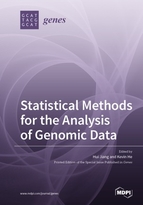Statistical Methods for the Analysis of Genomic Data
A special issue of Genes (ISSN 2073-4425). This special issue belongs to the section "Technologies and Resources for Genetics".
Deadline for manuscript submissions: closed (30 November 2019) | Viewed by 23903
Special Issue Editors
Interests: statistical genomics; bioinformatics; statistical computing
Special Issue Information
Dear Colleagues,
In recent years, technology breakthroughs have greatly enhanced our ability to understand the complex world of molecular biology. Rapid developments in genomic profiling techniques, such as high-throughput sequencing, have brought new opportunities and challenges to the fields of computational biology and bioinformatics. Furthermore, by combining genomic profiling techniques with other experimental techniques, many powerful approaches (e.g., RNA-Seq, ChIP-Seq, single-cell assays, Hi-C) have been developed in order to help explore the complex biological systems. As more genomic datasets become available, both in volume and variety, the analysis of such data has become a critical challenge as well as a topic of interest. Consequently, statistical methods dealing with the problems associated with these newly developed techniques are in high demand. This Special Issue will highlight the state-of-the-art statistical methods for the analysis of genomic data, and explore potential future directions for improvement.
Dr. Hui Jiang
Dr. Zhi He
Guest Editors
Manuscript Submission Information
Manuscripts should be submitted online at www.mdpi.com by registering and logging in to this website. Once you are registered, click here to go to the submission form. Manuscripts can be submitted until the deadline. All submissions that pass pre-check are peer-reviewed. Accepted papers will be published continuously in the journal (as soon as accepted) and will be listed together on the special issue website. Research articles, review articles as well as short communications are invited. For planned papers, a title and short abstract (about 100 words) can be sent to the Editorial Office for announcement on this website.
Submitted manuscripts should not have been published previously, nor be under consideration for publication elsewhere (except conference proceedings papers). All manuscripts are thoroughly refereed through a single-blind peer-review process. A guide for authors and other relevant information for submission of manuscripts is available on the Instructions for Authors page. Genes is an international peer-reviewed open access monthly journal published by MDPI.
Please visit the Instructions for Authors page before submitting a manuscript. The Article Processing Charge (APC) for publication in this open access journal is 2600 CHF (Swiss Francs). Submitted papers should be well formatted and use good English. Authors may use MDPI's English editing service prior to publication or during author revisions.
Keywords
- High-throughput sequencing
- Single-cell genomics
- Metagenomics
- Genomic data integration
- Computational biology
- Bioinformatics
- Statistical genomics
- Gene expression
- Gene regulation
- Biomarker discovery
- Gene network
- Functional genomics
- Precision medicine








